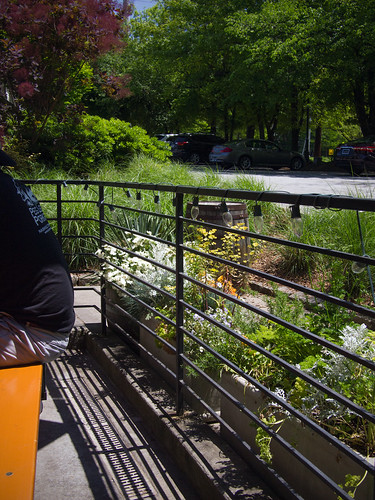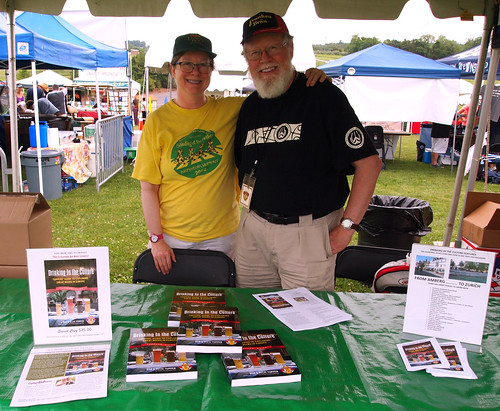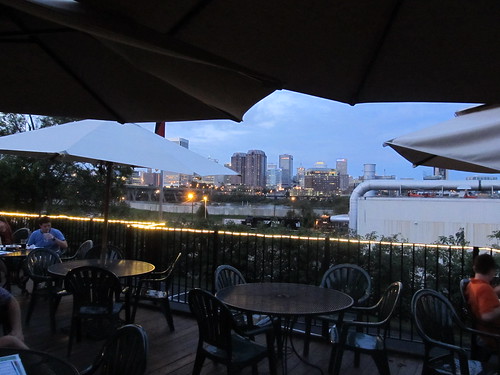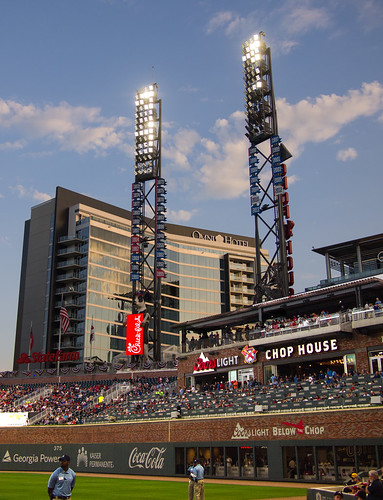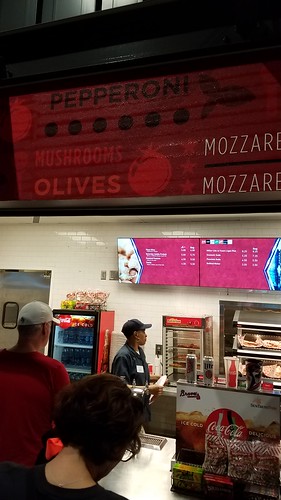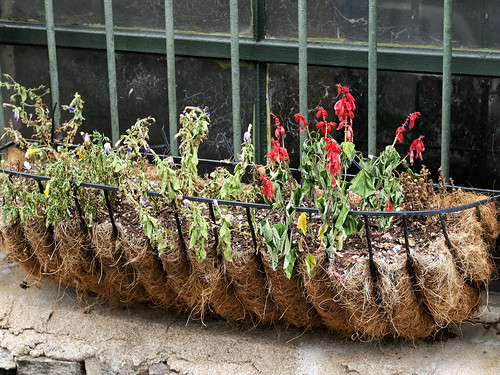Saturday, April 28, 2018
Pic(k) of the Week: Beer patio bijou
On encountering a brewpub in Atlanta, Georgia, an Instagrammer, tagging a friend, commented, "this is the brewery I was talking about ... that also has food!" In this new generation of brewery taprooms, a brewpub had become a pleasant anomaly to her. Les temps ont changé!
Pictured above, this was not that brewpub, but another, elsewhere in the same city on the same day. On a spring afternoon, its intimate outdoor beer patio was a bijou.
Wrecking Bar Brewpub, in Atlanta (Little 5 Points), Georgia, on 27 April 2018.
-----more-----
Saturday, April 21, 2018
Pic(k) of the Week: Close encounter of the leonine kind.
An intimate view of the incisors of a young (sub-Saharan) male African lion. Despite appearances, the big cat was merely yawning. Any closer approach was impeded by reinforced acrylic.
At Zoo Atlanta, Atlanta (Grant Park), Georgia, on 13 April 2018.
**************
Endangered species protection endangered
In 2015, the U.S. Fish and Wildlife Service placed the African lion (Panthera leo) under the protection of the U.S. Endangered Species Act.The nearly extinct lions of western and central Africa—a subspecies now called P. l. leo—will be listed as endangered. Only about 1,400 of these lions remain scattered across more than a dozen countries, including the critically endangered Asiatic lions of India (the cats on the two continents were not previously considered the same subspecies). Another lion subspecies—P. p. melanochaita of east and southern Africa—will be listed as threatened. There are about 17,000 to 19,000 lions left in this subspecies, most of which live in protected but restricted habitats.— Scientific American.
That turns out ohave been fortuitous timing for African lions. Earlier this month, Donald Trump's Department of the Interior indicated its intention to eliminate all future protections for threatened species, effectively gutting the 1973 Endangered Species Act.
Under section 4(d) of the Endangered Species Act, the FWS created regulations in 1978 which granted threatened species, or those approaching endangerment, the same blanket protections granted to endangered species. Broadly, these regulations prevent “take” of protected species—death, harm, or harassment from human activity, such as hunting, capturing, and, in some cases, destroying their habitat through development, logging, or other means. “If you’re a threatened species and you don’t have ‘take’ protections, you don’t really have any protections at all,” Noah Greenwald, the endangered species director at the Center for Biological Diversity, tells Mother Jones. The change could be disastrous for species like the North American wolverine, the gopher tortoise, and the Sierra Nevada red fox, which are proposed for listing, or are being considered for, threatened status in the future.— Mother Jones.
-----more-----
Saturday, April 14, 2018
Tuesday, April 10, 2018
De gustibus non est disputandum.
A few days ago, Jaime Jurado —who, among many beer business accomplishments, was the recent Head of Brewing Operations at Abita Brewing Company, in Louisiana— posted, to his personal Facebook page, a link to an article written by Bryce Eddings 1, at a site called The Spruce, entitled, "A Working Definition of Craft Beer. The attempt to define 'craft' beer is not as easy as you think."
As you might think, there was a large thread of responses. Mine covered one aspect of the question: the elusive definition of 'craft.' Given that this is my blog, I've expanded upon my response and unraveled it here.
**************
The [U.S.] Brewers Association 2 does NOT define what a 'craft' beer is. And, fortunately, it does not define 'craftsmanship,' either. It does, however, define what so-called 'craft' breweries are: its dues-paying members. It's a distinction often disregarded. The BA promulgated its newest 'definition' in 2014: "An American craft brewer[y] 3 is small, independent, and traditional."
Compare that to the BA's older, pre-2014, definition in which corn and rice had been deemed 'evil':
- Small: Annual production of 6 million barrels of beer or less (approximately 3 percent of U.S. annual sales). Beer production is attributed to the rules of alternating proprietorships.
- Independent: Less than 25 percent of the craft brewery is owned or controlled (or equivalent economic interest) by a beverage alcohol industry member that is not itself a craft brewer.
- Traditional: A brewer[y] that has a majority of its total beverage alcohol volume in beers whose flavor derives from traditional or innovative brewing ingredients and their fermentation. Flavored malt beverages (FMBs) are not considered beers.
Traditional: A brewer[y] who has either an all malt flagship (the beer which represents the greatest volume among that brewers brands) or has at least 50% of its volume in either all malt beers or in beers which use adjuncts to enhance rather than lighten flavor.
Four years before that, in 2010, the BA also changed its definition of a small brewery, making it a lot less small. It tripled the size limit for breweries from annual production of two million barrels or less ... to six million barrels. In other words, as the BA put it, it stopped penalizing member success. Or, in other words, it ended its worry about losing the advocacy and financial support of its largest member, the Boston Beer Company, who, at that point, was right at the two-million-barrel threshold. of course, now both Yuengling (allowed in, in 2014) and Boston Beer are closing in on the newer limit. Will what 'craft' is change again?
**************
New definitions
A 'craft' brewer(y) is a brewer(y) that pays dues to the [U.S.] Brewers Association. And a 'craft' beer? That's:- 1) a beer that tastes good, and/or
- 2) a beer made with craftmanship, and/or
- 3) a beer made with chemical-laden breakfast cereals, and/or
- 4) De gustibus non est disputandum 4.
- 2) a beer made with craftmanship, and/or
-----more-----
Monday, April 09, 2018
Drinking in the Culture: A checklist for Beer Gardens in Europe. (Beer Blogging Friday)
 The Session: Beer Blogging Friday is a monthly event for the beer blogging community, begun in March of 2007 by Stan Hieronymus of Appellation Beer and Jay Brooks of the Brookston Beer Bulletin. On the first Friday of every month, a pre-determined beer blogger hosts The Session, choosing a specific, beer-related topic, inviting all bloggers to write on it, and posting a roundup of all the responses received.
The Session: Beer Blogging Friday is a monthly event for the beer blogging community, begun in March of 2007 by Stan Hieronymus of Appellation Beer and Jay Brooks of the Brookston Beer Bulletin. On the first Friday of every month, a pre-determined beer blogger hosts The Session, choosing a specific, beer-related topic, inviting all bloggers to write on it, and posting a roundup of all the responses received.
For The Session #134, Friday, 6 April 2018, I was that pre-determined host and my topic was ... Beer Gardens.
Beer writers/raconteurs/travellers/tickers Bob and Ellie Tupper sent in a checklist for European beer gardens — a checklist that could be referenced universally (or, for now, globally). I've posted it here, today —Monday, 9 April— because, in the beer world and especially in a beer garden, it's always Friday in spirit. Allons-y, Alonzo!
***************
Drinking in the Culture
When we wrote Drinking In the Culture: Tuppers’ Guide to Exploring Great Beers in Europe [in 2015], we tried to identify the six best places in each of the twenty-four featured cities to experience the local beer culture. We succeeded in over twenty cities, but failed miserably in Munich: there were just too many. We finally compromised on the six best establishments in each of four different categories, only one of which was "beer garden." It came down to six criteria that lifted those six winners to the top of a crowded Munich field.
Here are those criteria, with a favorite or two in Germany and Austria for each of them.
- Accessibility
We only included places accessible by public transportation. German DUI laws are even stricter than in the U.S. We found a lovely, historic beer garden near Freising last year, but the round-trip cab ride came to over $70. The Augustiner Keller in Munich is two blocks from a tram stop and the S Bahn subway. - Prices
The price of a German Mass (short-filled liter) can vary from 6 to 9 Euros. In general, the closer to the center of the city, the more you’ll pay. The price of a liter at the Kloster Mülln garden in Salzburg is still just above the 6 Euro level. - Size
Intimate gardens can be attractive, but we love a really enormous one. The clanking of steins and rumble of 200-liter barrels, overlaid with hundreds of conversations, could be cacophonic, but to us, it’s a symphony. On a beautiful weekend night, the Munich Hirschgarten comes close to filling their 8,000 seats, and the hum is like a contented beehive you can hear for blocks. - Setting
Traditional German beer gardens evolved in the 19th century as brewers discovered that if you spread white gravel on the hilltop above the underground cellars where you kept the beer, then further shaded the white stone with leafy chestnut trees, it kept the cellars cooler. An unintended benefit was that this shady hilltop was a perfect place to drink that lovely beer. Some gardens have particularly good vistas: you can spot an Alp from Kloster Mülln, gaze at the massive Dom across the Danube from the Spital Brauerei garden in Regensburg, or feed the deer that mooch along the fence next to your table at the Hirschgarten. - Food
Almost every garden will have roast chicken and bratwurst, but the biggest and best of them go much farther. Fresh fish roasted over live coals, spare ribs, enormous spiral-sliced white radishes, massive roasted pork knuckles, and a wide array of salads and sweets almost always taste as good as they look. Food vendors indoors and out in the garden at Kloster Mülln offer a variety that gives this one an edge over the others. Or copy the locals and bring in your own picnic; almost all gardens allow it as long as you’re drinking their beer. - Beer
As important as this criterion would seem, it probably influences us the least. Almost every brewery with a good garden brews a fine helles lager. But, as Orwell noted, some are more equal than others. Munich’s Augustiner is sweet, but achingly clean, and somehow leaves you with no ache at all the next morning. Salzburg’s Augustiner brewery looms above the Kloster Mülln garden; being able to sit within meters of where the beer is born seems to make it taste even better. - Gemütlichkeit
Gemütlichkeit, or friendliness, is hard to judge on a limited number of visits. You’ll almost always sit at communal tables, so conversation is optional but usually available. On almost every one of our dozen visits to Kloster Mülln, spanning decades, we’ve made new best friends, only some of whom could speak more than a few words of English.
***************
— "We're Bob and Ellie Tupper, “DC’s original beer geeks” (Washington City Paper). We spent 35 years seeking beers all over Europe, amassing a database with over 32,000 entries, before writing Drinking In the Culture. In it, we describe the best places in Europe to visit in order to “drink in” the rich connections between beers and the societies that brew them.
We're currently working on Brews & Snooze, a guide to breweries and B&Bs of the Mid-Atlantic region, featuring places where you can visit a brewery and walk, not drive, back to where you're spending the night. In some cases, the journey back to your room involves only walking up a couple of flights of stairs. We hope to have the book in print by the end of the year."
The Tuppers maintain their own website and blog, called, punningly enough, CultureAle. The essay above —but illustrated with photographs— they'll be posting there soon. Until then, of course, you could read their book.
-----more-----
Sunday, April 08, 2018
Beer and the Great Outdoors. A Match Made in Heaven. (Beer Blogging Friday)
 The Session: Beer Blogging Friday is a monthly event for the beer blogging community, begun in March of 2007 by Stan Hieronymus of Appellation Beer and Jay Brooks of the Brookston Beer Bulletin. On the first Friday of every month, a pre-determined beer blogger hosts The Session, choosing a specific, beer-related topic, inviting all bloggers to write on it, and posting a roundup of all the responses received.
The Session: Beer Blogging Friday is a monthly event for the beer blogging community, begun in March of 2007 by Stan Hieronymus of Appellation Beer and Jay Brooks of the Brookston Beer Bulletin. On the first Friday of every month, a pre-determined beer blogger hosts The Session, choosing a specific, beer-related topic, inviting all bloggers to write on it, and posting a roundup of all the responses received.
For The Session #134, Friday, 6 April 2018, I was that pre-determined host and my topic was ... Beer Gardens.
Dave Gott —Vice President of Legend Brewing Company, in Richmond, Virginia— kindly sent in an essay on beer gardens in general and his beer garden in particular. He stated that he is "not a writer." I disagree.
***************
Beer and the Great Outdoors. A Match Made in Heaven.
I have been in the beer business for 27 years and the question I get the most is “what is the best beer”? My pat answer has always been “a free one” but I have begun to reconsider that answer and hone in on to a little more detail. A free one consumed on a nice sunny day when a warm breeze is blowing and you see the world as the glorious wonder that it is. Especially when there is no yard work to do.
Whether it is a deck, a porch, a true beer garden or just sitting in the grass, there is something special about that first beer outside in the spring. Hell, the Norwegians even have a special word for it. Utepils meaning outdoor lager.
The current craze of outdoor seating in our breweries and restaurants today is an expression of a much older tradition. In the German Biergarten, dating from the 19th century, beer, food, and music were enjoyed in an atmosphere the Germans called Gemütlichkeit. A word used to convey a state or feeling of warmth, friendliness, and good cheer. Drink a few steins and say that five times really fast.
At our Pub in Richmond, Virginia —Legend Brewing Company— we have a deck that seats 200 and has a spectacular view of the James River and the city skyline. We also have a beer garden that seats 80 at the front of our Pub. Let’s face it, you can’t have too much of a good thing. Our Portsmouth location has a beer garden overlooking the Elizabeth River with a view of the big navy vessels in dry dock. These are places where people sit, talk, trade ideas and get to know each other all under the big blue sky with a nice cold one in hand. The troubles of life fade away on that aforementioned warm breeze and all the world is at peace.
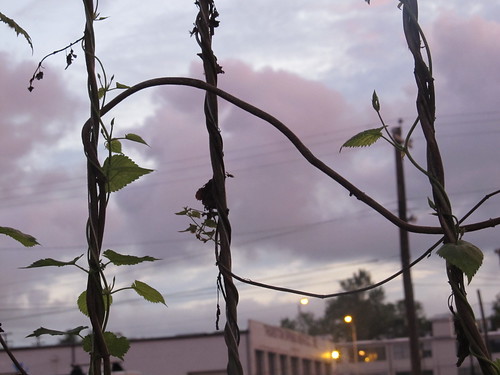
So what makes a good beer garden? My friends, the answer is simple. You do. It is neither the wood deck, slate patio, or spectacular view. It is the coming together —the community, and camaraderie— we share over our favorite beverage. Gemütlichkeit.
So, I bid you cheers and goodwill. The warm weather is coming and outside we will go! With beer in hand, of course.
***************
— Dave added that he has been in the beer business since 1991 and with Legend since 1996. He attended Longwood College in Farmville, Virginia, where he received a degree in Earth Science and Philosophy, and drank a lot of beer. After college, he worked and traveled extensively overseas and drank a lot of beer. The rest is history.
I would add that Legend is celebrating its 24th anniversary. Opened in 1994, it is, by far, Virginia's oldest operating 'craft' brewery. (The only Virginia brewery older is Anheuser-Busch's Williamsburg plant, which began operations in 1972.)
-----more-----
Saturday, April 07, 2018
Pic(k) of the Week: Oldest (continuously operating) franchise in baseball!
At the outset of the 2018 baseball season, the light poles at SunTrust Park displayed the championship and pennant flags for the Atlanta Braves.
Formed as the Boston Red Stockings/Red Caps in 1871, the team won its first championship in 1872. It is the longest continuously operating franchise in all of American professional sports. (The Chicago Cubs also were founded in 1871 but did not play for the two years following the Great Chicago Fire of 1871.) According to Wikipedia, the team adopted the nickname "Braves" in 1912. James Gaffney, owner of the team, was a member of New York City's political machine, Tammany Hall, which used an Indian chief as their symbol.
The Braves and the Chicago Cubs are the National League's two remaining charter franchises, debuting in the National League in 1876. The Red Stockings/Braves have won seventeen divisional titles, seventeen National League pennants, and three World Series championships —in 1914 as the Boston Braves, in 1957 as the Milwaukee Braves, and in 1995, in Atlanta— the only Major League Baseball franchise to have won the World Series in three different home cities.
**************
That was then. Now...
Where much of American professional sports is moving back to American cities' inner cores, embracing local, that's not the direction of the (Atlanta) Braves. After the conclusion of the 2016 season, the Braves moved from Turner Field, their downtown Atlanta ballpark, to SunTrust Park, in suburban Cobb County, a dozen miles northeast of the city. The new facility, unlike Turner Field, lacks serious public transportation; woe be to you if you lack a traffic app on your cell phone! It reeks of unfinished roads and interstate highway infrastructure. It excludes any street merchant presence. The whole thing has an anemic, un-baseball feel.And, the concessions serve no 'craft' beer.
Now, maybe that's a bit harsh, because it means that I'm adopting the [U.S.] Brewers Association's fungible definition of what craft is and, thus, excluding the good-tasting beer from Terrapin, a brewery in Athens, Georgia, but now majority-owned by Miller Coors. Terrapin beers indeed can be found at SunTrust, but in limited locations, in cans and at a few stands (and the Coors ChopHouse) on draught. But that's it (or all I saw). The majority of Georgia's bustling small-business beer appears to have been ignored.
And, then, on the day I visited, there was this.
Me: "May I have that pizza slice with mushrooms and olives?"
Concessionaire: Blank stare.
Me: "Mushrooms and olives like it says on the sign right above."
Concessionaire: "Oh, that's just marketing."
-----more-----
Friday, April 06, 2018
What is a DC beer garden? (Beer Blogging Friday)
 The Session: Beer Blogging Friday is a monthly event for the beer blogging community, begun in March of 2007 by Stan Hieronymus of Appellation Beer and Jay Brooks of the Brookston Beer Bulletin. On the first Friday of every month, a pre-determined beer blogger hosts The Session, choosing a specific, beer-related topic, inviting all bloggers to write on it, and posting a roundup of all the responses received.
The Session: Beer Blogging Friday is a monthly event for the beer blogging community, begun in March of 2007 by Stan Hieronymus of Appellation Beer and Jay Brooks of the Brookston Beer Bulletin. On the first Friday of every month, a pre-determined beer blogger hosts The Session, choosing a specific, beer-related topic, inviting all bloggers to write on it, and posting a roundup of all the responses received.
For The Session #134, today, I am that pre-determined host and my topic is ... Beer Gardens.
Keith Chamberlin, a non-blogger in Washington, D.C., kindly sent in a report on beer gardens there. I've posted it here.
***************
DC Beer Gardens
A newcomer that has been around for about 1 year is the Midlands Beer Garden at 3333 Georgia Ave. Their claim is an American craft beer garden. The place looks inviting with roll-up doors with approximately half their occupancy indoors with picnic tables outside for a total of about 250 people. They have 7 static taps, 7 local rotating and 7 imports that rotate. The imports are mostly German and Belgian while the 7 locals are small local beers and are typically not the most common ones to find.
Garden District beer garden is a small patio beer garden that doesn't open during inclement weather as most of their seating is outside. There is a little inside but it is tight! They only have German beer and American craft beer, about 8 taps, and their food is focused on good bbq. The seating seems to be enough for 100-150 people and is a good location around other restaurants and bars as well as the Black Cat music venue.
Another DC beer garden that is not quite in DC is Denizen's Brewing Company. I include them because it is a brewery and a unique place. Close to the Silver Spring Metro they are open year round but the beer garden only in good weather. The beer garden also has beer service on the patio when busy as well as two indoor bars. The food is decent and has rotated with different vendors a couple times since opening. Inside there is an upstairs and downstairs bar with the brewery on the lower level. The outdoor seating with 24 large tables, each holding about 8 people and there is cornhole for adults and kids. They like to be called a local watering hole and their slogan is 'unified by beer', socially bringing people together.
DC and the surrounding metro area has many other rooftop beer patio and gardens that are worthy of a visit with the local craft beer scene being about as good as it ever has been. Come for a visit!
***************
— Keith added that he is a DC homebrewer and beer advocate who's an engineer during the day.
Thank you, Keith!
-----more-----
A sad beer garden story (for Beer Blogging Friday).
We walked in one early Sunday afternoon, happily anxious to sit outside at this, a recently opened bar, with "Beer Garden" in its name.
**************
A forlorn fable
There was no one in the bar except for two bartenders, talking to each other. We stood there for a minute, awkwardly unacknowledged. Eventually, we asked, "Hello. Where's the beer garden?"Motioning with a thumb, one replied, "Out there," and returned to the conversation.
We walked out there, down some stairs to a crushed-stone patio, walled in with a high fence and the stone side of a propinquant business. The garden, as it was, comprised a few picnic tables (there was one with an umbrella), one unblooming Crepe Myrtle (strange, as the rest of the city was awash with the trees' glorious blossoms), and a few flower boxes attached to a wall, in which sat a few scraggly specimens. A water hose, lying nearby, was apparently unused.
Then we sat and sat, until we realized that we would not be served. Walking back inside, I saw the two still engaged in conversation, now standing at the opposite end of the bar to one additional customer.
"What beers do you have?" Again a gesture, this time toward a board above and behind the bar, listing several local draught options. "Do you have a printed list? I won't be able to remember all for my friend outside." "No," was the one-word answer.
I made a decision and carried my beers outside. We each drank our beer, and, when finished, returned our empty glasses to the bar, paid our tab (tipped?), and left...into the bright July sunshine, not to return.
*************
Is that all there is?
To us, a beer garden has a mythical ethos, like a German outdoor sibling to the coziness of a British pub. But there, that day, the fable seemed extirpated, the expectation denied. Had we been so wrong? Is a beer garden simply a place for beer drinking minus any trappings except for an outdoor setting?So, today, we're enlisting the aid of others. Help vivify our myth.
***************
Beer Blogging Friday
 Teh Session: Beer Blogging Friday is a monthly event for the beer blogging community, begun in March of 2007 by Stan Hieronymus of Appellation Beer and Jay Brooks of the Brookston Beer Bulletin. On the first Friday of every month, a pre-determined beer blogger hosts The Session, choosing a specific, beer-related topic, inviting all bloggers to write on it, and posting a roundup of all the responses received.
Teh Session: Beer Blogging Friday is a monthly event for the beer blogging community, begun in March of 2007 by Stan Hieronymus of Appellation Beer and Jay Brooks of the Brookston Beer Bulletin. On the first Friday of every month, a pre-determined beer blogger hosts The Session, choosing a specific, beer-related topic, inviting all bloggers to write on it, and posting a roundup of all the responses received.Today, for The Session: Beer Blogging Friday #134, I am that pre-determined (read: volunteered) host. And I've determined that my topic is ... Beer Gardens. Today, I'm asking all beer bloggers to write on beer gardens. If you do, tell me about it by:
- Providing a link in the comment section here, below, or
- Posting a link at my earlier, anouncement post —What (and where) is a Beer Garden? Announcement for The Session: Beer Blogging Friday #134— or
- Tagging me on Instagram (tcizauskas/), or
- Tagging me on Twitter (@Cizauskas), or
- Posting a link and comment on my Facebook page: (YoursForGoodFermentables/).
**************
A better story
Not a blogger, but an active Twitter-er or Instagrammer? Just tag/hashmark as above. Or a beer writer without a blog? You can participate as well. Here's how.Once the day is done, I'll post summaries and links in a roundup. But, please, today, tell me a good Beer Garden story, like the one pictured below. At least one better than my sad one.
-----more-----

